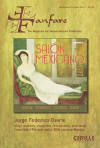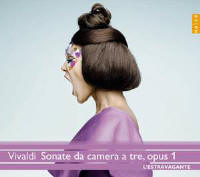Texte paru dans: / Appeared in: Code-barres / Barcode: 709861305353
|
|
|
Reviewer:
Raymond Tuttle
I have listed these works
under the title by which they will be familiar to most listeners. Note,
however, that Naïve’s packaging calls them “Sonate da camera a tre,” and
that in 1705, they were published as Suonate da camera a tre, due violone o
cembalo, and some CDs use that language instead. Be that as it may, the
present disc gives only nine of these works—a second disc would have been
needed to complete the set, and I am guessing that we will see it sooner or
later.
Even though this is op. 1,
these were not, of course, Vivaldi’s first compositions, only his first set
of works to be published by the Venetian publisher Giuseppe Sala. They are,
in essence, sonatas for two violins and continuo. The “default setting” for
the continuo on this recording is cello and/or harpsichord, but
L’Estravagante sometimes invites in a theorbo or an organ, presumably to add
variety. Given the ensemble’s rather homoge-neous performance style, this is
welcome.
I’ve heard these musicians
play Buxtehude’s op. 1 and op. 2 sonatas (on the Arts label), and enjoyed
those performances immensely. Perhaps it is simplistic of me to think so,
but I would have thought that an Italian ensemble would be even more at home
with Vivaldi. It turns out that L’Estravagante’s lean and rigorous playing
suits Buxtehude better; their Vivaldi is a bit more ascetic than I would
like it to be. The playing isn’t dull, but it does lack fancy. The last
sonata, which is a set of variations on La Follia, can be exciting as hell.
L’Estravagante generates plenty of light, but not so much heat. The ensemble’s cellist is Francesco Galligioni, and the harpsichordist is Maurizio Salerno. The violinists are Stefano Montanari and Stefano Rossi. The two violinists are separated on this recording far enough to create antiphonal effects, and this was a good idea. The reverberant recording location is perhaps less successful, but it does give the sound more warmth than the “what me, play with vibrato?” playing lends.
As this is part of Naïve’s
massive Vivaldi series, the slipcase and booklet cover feature a bizarrely
decorated and coiffed model seen from the side, with her mouth gaping
threateningly. Apparently many people are bothered by this cover art, but
surely it is better than yet another generic painting by Guardi or Canaletto! I can’t call these readings definitive, although they are certainly bracing and well played. I retain a preference for the old-school violin-playing of Salvatore Accardo and Franco Gulli, with Bruno Canino and Rohan de Saram. Those performances, once available as a two-CD set from Philips, now can be had only as part of a 19-CD box reissued by Newton Classics. In other words, if you’re interested, you might want to try your favorite used CD retailers instead. | |
|
|
|
|
|
|
|
Cliquez l'un ou l'autre
bouton pour découvrir bien d'autres critiques de CD |
|




